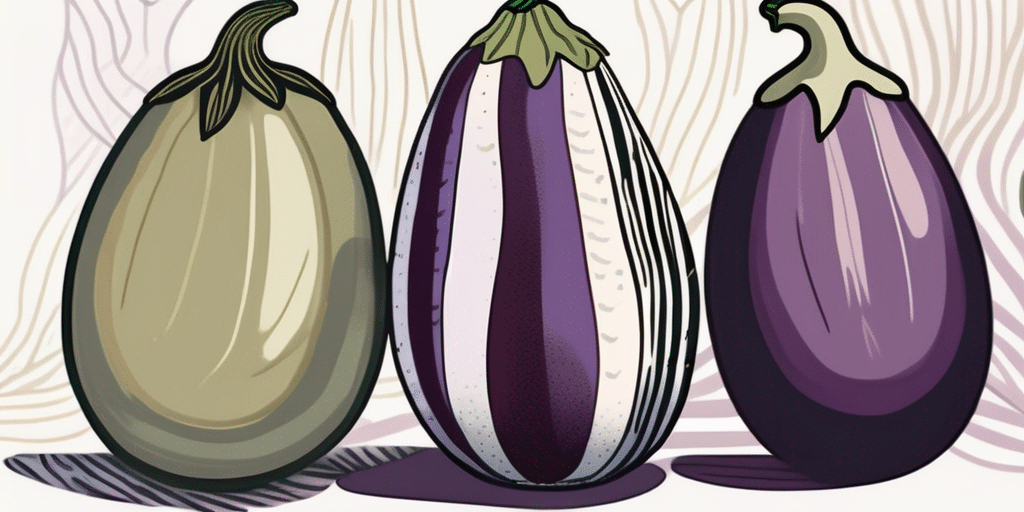Are you an eggplant lover looking to explore different varieties of this versatile vegetable? If so, you may have come across two popular types: Kamo Eggplant and Shikou Eggplant. In this article, we will compare these two eggplant varieties, discussing their characteristics, benefits, drawbacks, and which one might be the right choice for you.
What is Kamo Eggplant?
Kamo Eggplant, also known as Kyoto Eggplant, is a Japanese heirloom variety that originated in the Kamo region of Japan. It is a medium-sized eggplant with a unique shape and vibrant purple skin. The flesh is creamy white and has a mild, sweet flavor with a hint of bitterness. Kamo Eggplant is highly valued for its tender texture and delicate flavor, making it a popular choice in Japanese cuisine.
Legend has it that Kamo Eggplant was first cultivated by monks in the serene gardens of Kyoto, where its exquisite taste and elegant appearance captured the attention of local chefs and food enthusiasts. This eggplant variety is not only prized for its culinary attributes but also for its historical significance in Japanese gastronomy.
Pros of Kamo Eggplant
- Kamo Eggplant has a mild, sweet flavor with a subtle bitterness that adds depth to dishes.
- The creamy white flesh of Kamo Eggplant is tender and has a melt-in-your-mouth texture.
- It is a versatile vegetable that can be used in various dishes, such as stir-fries, curries, grilled, or roasted.
- The vibrant purple skin adds a pop of color to dishes and makes it visually appealing.
Furthermore, Kamo Eggplant is not only a culinary delight but also a nutritional powerhouse. Packed with vitamins, minerals, and antioxidants, this eggplant variety offers a range of health benefits, including improved digestion and heart health. Its low calorie and high fiber content make it a great addition to a balanced diet, promoting overall well-being.
Cons of Kamo Eggplant
- Due to its delicate texture, Kamo Eggplant can become mushy if overcooked.
- The mild flavor may not be as bold as some other eggplant varieties.
What is Shikou Eggplant?
Shikou Eggplant, also known as Chinese Eggplant, is a popular variety in Chinese cuisine. It is a long and slender eggplant with glossy, dark purple skin. The flesh is creamy white and has a slightly denser texture compared to Kamo Eggplant. Shikou Eggplant has a mildly sweet and savory flavor, making it a favorite in stir-fries and braised dishes.
When selecting Shikou Eggplant at the market, look for ones that are firm and free of blemishes. The glossy skin should be taut and vibrant in color, indicating freshness. To prepare Shikou Eggplant, simply wash it, trim the ends, and slice or dice as needed for your recipe. Some chefs recommend salting the eggplant slices before cooking to draw out excess moisture and reduce any potential bitterness.
Pros of Shikou Eggplant
- Shikou Eggplant has a slightly denser texture that holds up well in stir-fries and braised dishes.
- The mild and savory flavor of Shikou Eggplant adds a delightful taste to various Asian dishes.
- Its long and slender shape makes it easier to cut and cook.
- The glossy, dark purple skin is visually appealing and adds an elegant touch to dishes.
Cons of Shikou Eggplant
- Shikou Eggplant has more seeds compared to other varieties, which some people may find undesirable.
- It can sometimes have a slightly bitter taste if not cooked properly.
For those looking to experiment with Shikou Eggplant in their cooking, consider trying it in a classic Chinese dish like Sichuan-style eggplant stir-fry or a fragrant eggplant and garlic sauce. The versatility of Shikou Eggplant allows it to absorb flavors well, making it a great addition to vegetarian and meat-based dishes alike. Whether you’re a seasoned chef or a home cook exploring new ingredients, Shikou Eggplant is a delicious and nutritious option to incorporate into your culinary repertoire.
Is Kamo Eggplant or Shikou Eggplant Right for You?
Now that we have explored the characteristics of both Kamo Eggplant and Shikou Eggplant, let us consider which one might be the right choice for you.
If you enjoy a delicate and mild flavor with a tender, melt-in-your-mouth texture, Kamo Eggplant is an excellent choice. Its versatility allows you to experiment with various cooking methods, bringing out its unique flavor profile.
Originating from Japan, Kamo Eggplant is known for its slender shape and vibrant purple color. Its thin skin cooks quickly and is perfect for dishes where you want the eggplant to almost dissolve into the sauce, creating a luscious texture. Whether you roast, grill, or sauté Kamo Eggplant, its subtle taste will complement a wide range of ingredients, making it a versatile option for both vegetarian and meat-based dishes.
On the other hand, if you prefer a slightly denser texture that holds its shape well in stir-fries and braised dishes, and enjoy a mildly sweet and savory taste, Shikou Eggplant would be a great pick. It is particularly popular in Chinese and other Asian cuisines, adding a delightful touch to your culinary creations.
Hailing from China, Shikou Eggplant, also known as Chinese eggplant, is shorter and thicker than its Japanese counterpart. Its flesh is creamier and less seedy, making it a favorite for dishes where you want the eggplant to retain its shape and soak up the flavors of the dish. Shikou Eggplant is commonly used in dishes like Szechuan eggplant stir-fry or braised eggplant in garlic sauce, where its ability to absorb sauces and spices shines through.
Ultimately, the choice between Kamo Eggplant and Shikou Eggplant comes down to personal preference and the specific dish you are planning to make. Feel free to try both varieties and see which one you enjoy the most!
Frequently Asked Questions
1. Are Kamo Eggplant and Shikou Eggplant the same?
No, Kamo Eggplant and Shikou Eggplant are different varieties with distinct characteristics. While they both belong to the eggplant family, they differ in terms of size, shape, texture, and flavor.
2. Where can I buy Kamo Eggplant and Shikou Eggplant?
You can find Kamo Eggplant and Shikou Eggplant at select Asian grocery stores or specialized produce markets. Alternatively, you may consider growing them in your own garden if you have the necessary space and resources.
3. Can I substitute Kamo Eggplant for Shikou Eggplant in recipes and vice versa?
While Kamo Eggplant and Shikou Eggplant have their unique characteristics, you can generally substitute one for the other in most recipes without significant changes in taste or texture. However, keep in mind that the flavor and texture may vary slightly.
4. What are some popular recipes using Kamo Eggplant and Shikou Eggplant?
For Kamo Eggplant, popular recipes include Nasu Dengaku (grilled eggplant with miso glaze), Tempura, and Stir-fried Eggplant with Garlic Sauce. As for Shikou Eggplant, dishes like Sichuan Eggplant, Eggplant with Garlic Sauce, and Eggplant and Tofu Clay Pot are highly regarded in Chinese cuisine.
Now that you have learned about the differences between Kamo Eggplant and Shikou Eggplant, as well as their pros, cons, and potential uses, you can make an informed decision when choosing which variety to incorporate into your next culinary adventure. Enjoy the unique flavors and textures offered by these two delectable eggplant varieties!
But wait, there’s more to know about these fascinating eggplant varieties! Let’s dive deeper into their origins and cultivation methods.
Kamo Eggplant, also known as Kyoto Eggplant, hails from the Kamo region in Japan. It is highly prized for its tender flesh and mild, slightly sweet flavor. The eggplants are typically small to medium-sized, with a glossy purple skin and a slender shape. Kamo Eggplant is often used in traditional Japanese cuisine, where it is valued for its ability to absorb flavors and complement various dishes.
On the other hand, Shikou Eggplant, also referred to as Chinese Eggplant, has its roots in China. It is a staple in Chinese cooking and is known for its long, slender shape and vibrant purple skin. Shikou Eggplant has a slightly firmer texture compared to Kamo Eggplant, making it ideal for stir-frying and braising. Its flavor is slightly more robust, with a hint of bitterness that adds depth to dishes.
Start Cultivating Your Eggplant Varieties Today!
Ready to bring the rich flavors of Kamo and Shikou Eggplants from your garden to your table? Subscribe for free to How to Grow Everything and unlock a world of expert gardening knowledge. Whether you’re a novice or a seasoned green thumb, our tailored advice will help you build the garden of your dreams. Receive the best gardening tips, special offers, and insightful articles, all customized to your grow zone and interests. Join our family of passionate gardeners and transform your gardening experience—100% free, no spam, just pure gardening gold!





